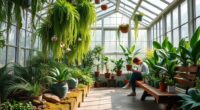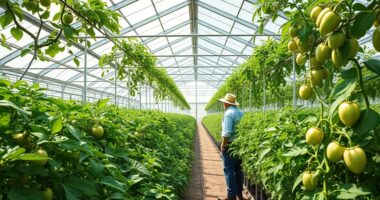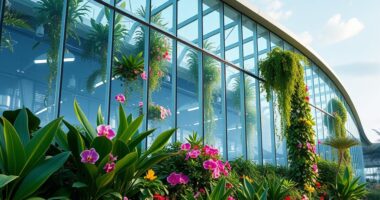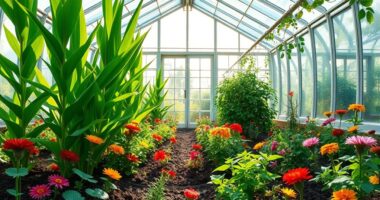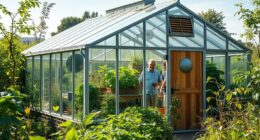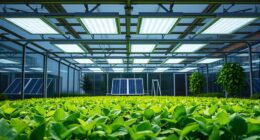A greenhouse classroom uses eco-friendly materials and energy-efficient systems to create a sustainable learning space. It encourages hands-on activities like planting and monitoring growth, helping students actively engage with ecological concepts. Collaboration across subjects fosters teamwork and critical thinking, while community involvement showcases practical sustainability practices. This setup transforms traditional lessons into immersive experiences that motivate students and develop environmental awareness. Keep exploring to discover how these innovative spaces inspire future eco-conscious leaders.
Key Takeaways
- Greenhouses in education provide hands-on learning experiences about plant growth, ecology, and sustainability principles.
- They serve as living classrooms, demonstrating eco-friendly design, energy efficiency, and water conservation techniques.
- Greenhouse projects foster student collaboration, critical thinking, and interdisciplinary skills across science, art, and social studies.
- Utilizing greenhouses encourages community engagement through sharing projects, promoting environmental awareness and lifelong sustainability commitment.
- Incorporating greenhouses transforms traditional lessons into immersive, experiential activities that inspire future environmental leaders.
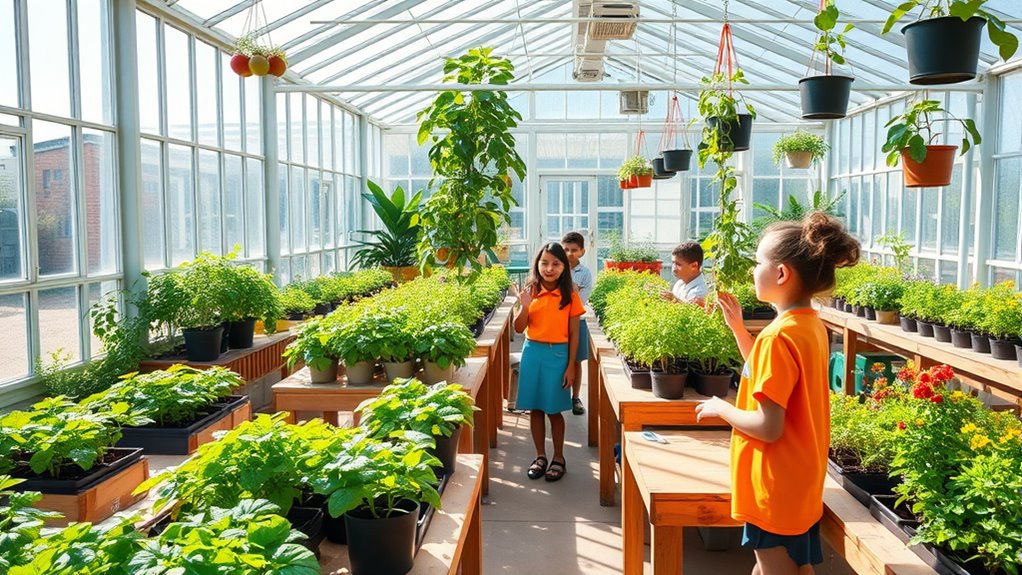
Have you ever wondered how students can learn about plants and sustainability in a hands-on way? Using a greenhouse classroom offers a dynamic environment where students don’t just read about ecological concepts—they experience them firsthand. When you incorporate a greenhouse into your educational setting, you create a space that emphasizes sustainable design. This means that the greenhouse isn’t just a conventional structure; it’s built with eco-friendly materials, energy-efficient systems, and water-saving technologies. As a result, students see how sustainable design principles can be applied practically, inspiring them to think about environmental impacts beyond the classroom. The greenhouse becomes a living example of how thoughtful architecture and conservation efforts go hand in hand, making abstract ideas tangible and relevant.
A greenhouse classroom models sustainable design through eco-friendly materials and energy-efficient systems, inspiring practical environmental awareness.
Engaging students in the process of growing plants and maintaining the greenhouse fosters active student engagement. Instead of passively absorbing information, they get involved in every step—planting seeds, monitoring growth, managing watering schedules, and troubleshooting issues. This hands-on participation helps deepen their understanding of biological processes and ecological relationships. It also cultivates a sense of responsibility and ownership over their environment, which is essential for fostering environmental stewardship. As students witness the direct results of their efforts, they develop a stronger connection to sustainability concepts, realizing how small actions can have meaningful impacts on the planet. Incorporating sustainable design into the greenhouse setting demonstrates the real-world application of environmental principles and encourages innovative thinking.
A greenhouse classroom also encourages collaboration and problem-solving. Working together on projects like composting, creating native plant gardens, or designing energy-efficient systems challenges students to think critically and communicate effectively. These activities promote teamwork and help develop skills that are valuable beyond the classroom. Additionally, the greenhouse is a versatile learning space that can be integrated into various subjects—science, math, art, and even social studies—making education more interdisciplinary and engaging. By doing so, you make learning more relevant and exciting, which increases student motivation and participation.
Furthermore, a greenhouse classroom can serve as a catalyst for community involvement. Students can share their projects with families, local organizations, or school visitors, showcasing sustainable practices and innovative ideas. This not only amplifies student engagement but also reinforces the importance of community-driven environmental initiatives. When students see their work making an impact, they’re more likely to develop a lifelong commitment to sustainability. Overall, incorporating a greenhouse into education transforms traditional lessons into immersive experiences that inspire future environmental leaders, all while demonstrating the power of sustainable design and active student participation.
Frequently Asked Questions
How Can Greenhouses Improve Students’ Understanding of Climate Change?
Greenhouses help you understand climate change by showing how plants adapt to changing conditions. Through hands-on experiments, you see how plant adaptation affects growth and survival. You also learn about the carbon cycle, observing how plants absorb CO2 and influence climate. This real-world experience makes complex concepts tangible, deepening your understanding of how human actions impact the environment and emphasizing the importance of sustainable practices.
What Safety Precautions Are Necessary for Students Working in Greenhouses?
When working in a greenhouse, you need to prioritize hazard prevention and follow supervision protocols to keep students safe. Guarantee proper training on handling tools and chemicals, and always supervise activities closely. Make sure students wear protective gear like gloves and goggles, and set clear rules for safe behavior. Regularly inspect equipment and the environment to prevent accidents. These precautions help create a safe, productive learning space for everyone.
How Do Greenhouses Accommodate Different Educational Levels?
Think of a greenhouse as a versatile classroom garden, where each plant represents a different learning level. You adapt the environment for student engagement by tailoring activities and adjusting the curriculum to meet diverse needs. Whether students are beginners or advanced, you can modify experiments, provide different tools, or assign varied tasks. This guarantees every learner blossoms at their own pace, making education in greenhouses inclusive and effective for all levels.
What Are the Costs Involved in Setting up a Greenhouse Classroom?
When considering the costs involved in setting up a greenhouse classroom, you should start with the initial investment, which includes purchasing the structure, equipment, and supplies. Additionally, factor in ongoing expenses like utilities, maintenance, seeds, and plant care supplies. These costs can differ depending on the size and sophistication of your greenhouse. Planning a budget helps make certain you can sustain the project long-term and provide a valuable learning environment.
How Can Greenhouses Be Integrated Into Existing Science Curricula?
Think of your science curriculum as a garden, ready to bloom with new ideas. You can integrate greenhouses by including hands-on lessons like plant propagation, which brings theory to life. Use the greenhouse to teach pest management strategies, making science tangible and engaging. This approach transforms lessons into an ecosystem where students actively participate, fostering curiosity and real-world understanding. Greenhouses become the heartbeat of your classroom’s learning garden.
Conclusion
By incorporating greenhouses into your classroom, you create a dynamic learning environment that fosters curiosity and hands-on experience. You’ll see students develop a deeper understanding of science, sustainability, and teamwork. Isn’t it time you gave your students the chance to grow both plants and knowledge side by side? Embracing greenhouses in education isn’t just about plants; it’s about nurturing future environmental stewards who can make a real difference.

